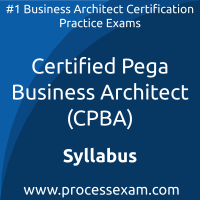 To achieve the professional designation of Certified Pega Business Architect from the Pega, candidates must clear the CPBA Exam with the minimum cut-off score. For those who wish to pass the Pega Business Architect certification exam with good percentage, please take a look at the following reference document detailing what should be included in Pega PEGACPBA24V1 Exam preparation.
To achieve the professional designation of Certified Pega Business Architect from the Pega, candidates must clear the CPBA Exam with the minimum cut-off score. For those who wish to pass the Pega Business Architect certification exam with good percentage, please take a look at the following reference document detailing what should be included in Pega PEGACPBA24V1 Exam preparation.
The Pega CPBA Exam Summary, Sample Question Bank and Practice Exam provide the basis for the real Certified Pega Business Architect (CPBA) exam. We have designed these resources to help you get ready to take Certified Pega Business Architect (CPBA) exam. If you have made the decision to become a certified professional, we suggest you take authorized training and prepare with our online premium Pega Business Architect Practice Exam to achieve the best result.
Pega CPBA Exam Summary:
| Exam Name | Certified Pega Business Architect |
| Exam Code | CPBA |
| Exam Fee | USD $190 |
| Exam Duration | 90 Minutes |
| Number of Questions | 50 |
| Passing Score | 65% |
| Format | Multiple Choice Questions |
| Books / Trainings | Class Schedule |
| Schedule Exam | Pearson VUE |
| Sample Questions | Pega PEGACPBA24V1 Exam Sample Questions and Answers |
| Practice Exam | Certified Pega Business Architect (CPBA) Practice Test |
Pega Business Architect Syllabus Topics:
| Topic | Details | Weights |
|---|---|---|
| Pega Express |
- Articulate the benefits and best practices of Pega Express delivery approach - Describe the Pega Express values and best practices framework - Describe the process and benefits of Directly Capture Objectives (DCO) - Describe the four phases of a Pega Express Delivery and terminology |
10% |
| Case Management |
- Design a case lifecycle, set case statuses, add instructions to tasks - Add a service level agreement; configure urgency, goals, deadlines, passed deadlines - Route assignments to users, work groups, work queues - Configure and send email correspondence - Identify duplicate cases - Identify and add optional actions - Add optional actions to a workflow - Automate workflow decisions using conditions - Pause and resume case processing; wait steps - Skip a stage or process - Configure child cases - Understand when to use automation shapes - Create and manage teams of users |
30% |
| Data and Integration |
- Configure data objects, data relationships, and data records - Capture and present data; fields, field types, and views - Identify and create calculated values - Validate data; create and configure data validation rules by using business logic - Manipulate application data, set default property values, configure data transforms |
15% |
| Security |
- Describe the relationship between personas, operators, and access groups - Articulate the difference between authorization and authentication |
5% |
| User Experience |
- Group fields to create views - Add and remove fields in views - Configure user interface elements and portal content - Configure form appearance, visibility settings, and controls |
10% |
| Application Development |
- Describe the role and skills required of a Pega Business Architect - Identify the stakeholders on a Pega project - Articulate the benefits of Pega’s Center-out™ business architecture - Describe the value of developing an application in App Studio - Describe the role of rules, rulesets, classes - Articulate the value of generative AI - Describe Pega’s CI/CD pipeline and Deployment Manager - Communicate using collaboration tools - Manage application development; user stories, feedback, bugs - Use the Case Type Backlog and Estimator tool to scope a Pega Platform project |
25% |
| Reporting |
- Describe the benefits of using Insights - Create visualizations using tables and charts - Use columns, filters, and sorting |
5% |
Both Pega and veterans who’ve earned multiple certifications maintain that the best preparation for a Pega CPBA professional certification exam is practical experience, hands-on training and practice exam. This is the most effective way to gain in-depth understanding of Pega PEGACPBA24V1 concepts. When you understand techniques, it helps you retain Pega Business Architect knowledge and recall that when needed.
